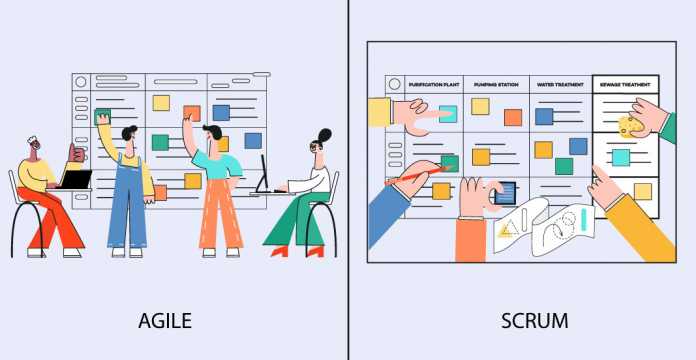
There are a lot of times when people use the terms Agile and Scrum interchangeably, which should not be the case. Even though Agile and Scrum serve the same purpose for companies, they are not necessarily the same. It would be like comparing water to ice. To help you understand the differences between them, we have brought this ‘Agile vs Scrum’ article.
When it comes to Agile, it is a set of principles and guidelines that organizations follow, which use an iterative approach to help them with software development. Scrum, on the other hand, is a list of rules that companies and team members follow as a part of their Agile software development process.
For example, in a survey of 101,592 software developers, it was found that 85.9% of them used Agile in their work, but this does not mean that they used the Scrum techniques and principles. To put it simply, all teams that implement Scrum techniques and principles are Agile, but not all Agile teams implement Scrum.
To better understand Agile and Scrum methodologies, let us understand how each methodology works.
What is Agile?
When software development teams claim that they are Agile, they mean that they have put a lot of development methodologies to use that use a very iterative development process. This only works in an incremental manner. The Agile methodology creates an environment for employees that focuses on constantly evolving based on the changing requirements and needs of the customer. This evolution is successfully brought about by collaborating within self-organizing teams as well as with cross-functional teams.
The Agile method creates a more disciplined approach to project management. Teams use a set of best practices to achieve their goals in the shortest amount of time possible. This helps teams deliver software of high quality. It improves the way businesses approach and completes their projects because it helps development teams align their objectives and outcome of the project with the customer’s needs.
The Agile way is a big shift from the traditional waterfall method because, in the traditional way, all the business or project requirements have to first be analyzed and documented by members at higher levels before starting the development. Here, with the Agile methodology, the requirements are not set in stone and evolve with each iteration, creating quite a lot of flexibility and room for growth during the software development cycle.
What is Scrum?
Scrum is a part of the Agile methodology. This means that it ultimately follows the same set of guiding principles, but it is more refined. Scrum is the most popular subset of the Agile method. It is also a flexible method used for software development. It is not a set technique or process that can be implemented easily. It is a framework that can be adapted to suit each individual company’s or team’s needs so that they can address problems well and deliver a product of high quality.
Scrum is an extremely popular Agile methodology. A recent survey conducted with more than 2,000 participants found that out of all the IT teams that used Scrum, 97% of them were very happy with their project success rate and will continue to use Scrum methods in the future.
What makes Scrum different from Agile?
The software development process in Scrum is done in sprints that can last for one, two, or even three weeks at most. It is done by a Scrum Team, which is made up of the Product Owner, the Scrum Master, and the Development Team.
The Product Owner takes over the biggest role of maximizing the value created from the product built by the Development Team. The Scrum Master is responsible for making sure that all the rules, theories, and practices of the Scrum framework are being followed by the Scrum Team. Finally, the Development Team is made up of a few self-organizing professionals who are in charge of creating product increments with each sprint or iteration.
Agile vs Scrum: What are the Differences?
Agile is a total methodology used by developers that are founded on using an iterative and incremental approach to software development, whereas Scrum is a part of Agile, a type where companies and teams can implement Agile principles in their workflow. With Scrum, incremental builds take place quite often, between one and three weeks.
When it comes to usage, Agile can be used for virtually any business environment that has a small team of experts, whereas the Scrum method is more specifically created for an environment where the requirements keep changing at a fast rate. To create an effective Agile environment, there has to be a strong sense of leadership to direct the change, whereas when it comes to Scrum, the main focus is on creating a self-organizing, cross-functional team instead.
Since the Scrum sprints happen very frequently, it can be considered to be a more flexible type of Agile methodology. The short duration of the sprints makes it more flexible and responsive when it comes to changes. Agile teams need to have constant collaboration and face-to-face interactions whereas the Scrum interactions take place at a daily stand-up every morning with the Scrum Team.
The principles of Agile and Scrum might be similar, but they are not the same. Agile principles focus more on accepting changing requirements at all stages in the development process and working throughout, on a daily basis, until the project is complete. Its main focus is to develop to achieve technical excellence and the team is required to adjust and adapt their behavior depending on project requirements.
The Scrum principles are focused more on self-organization to create shared ownership within the team, creating an environment that supports and encourages growth and creativity. It also focuses on collaborating with the rest of the team by creating awareness about the progress of the project to create the highest value. Another important principle of Scrum is time constraint. The Scrum Teams work in extremely short sprints to maximize their value from each sprint. Just like Agile, the Scrum process is also an iterative one, the only difference is that the cycles repeat a lot more frequently with Scrum.
Agile vs Scrum: What are the Similarities?
Since Scrum is a part of Agile, they have the same goals and overall objectives. The Scrum method is just a more specific way of achieving the goal. They both have collaborative iterations, focus on creating a flexible environment, and more. The Scrum method is more flexible in a rapidly changing environment, but since it has been narrowed down to a framework, it can be restrictive as well.
Again, the Scrum method will always be Agile, but all Agile approaches may not always be Scrum. To implement either method in an organization or for a particular project, team members need to be trained and coached on the guiding principles of both Agile and Scrum. Agile and Scrum, both ensure a seamless transition and a faster delivery for all projects.
So, what are your thoughts on ‘Agile vs Scrum’? Let us know in the comments. Meanwhile, some of the popular Agile and Scrum courses that individuals and enterprise teams can take up are:
- CSM Certification
- CSPO Certification
- SAFe Scrum Master Certification Training
- Agile Scrum Foundation Certification Training
- Agile Scrum Master Certification Training
- PRINCE2 Agile Foundation Certification Training














